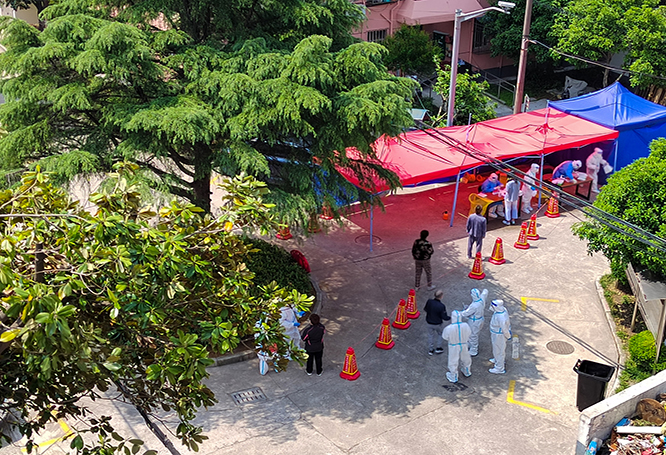Shanghai's screening, control measures take visible effect

Shanghai's recent PCR plus antigen screening and other control measures are showing growing effects, with a rising number of residents now in precautionary areas and fewer still under lockdown, according to the city's health commission.
A total of 192 COVID-19 infections were detected during at-risk people screenings between May 1 and 3, accounting for 1.07 percent of the total new infections in the city, said Zhao Dandan, deputy director of the commission.
At-risk groups refers to people in controlled and precautionary areas, as well as those who voluntarily go to fever clinics and receive polymerase chain reaction tests.
If less than one positive case is found in every 100,000 residents among these groups for three consecutive days, the city will "basically have achieved the zero social transmission" goal, when residents will be able to enjoy more freedom.
According to the results of the PCR plus antigen screening, a total of almost 15.8 million local residents, or some 63 percent of Shanghai's total population, are in precautionary areas – communities, villages and businesses without a positive case in the last two weeks.
The number of residents in locked-down areas has fallen to 2.39 million, while 5.19 million people are in controlled areas, Zhao revealed.
Shanghai's daily infection number declined by about 12 percent on day to a total of 4,982 on Tuesday. It reported 16 more COVID-19 deaths on Tuesday – 4 fewer than on Monday – with the casualties having an average age of 82.9 years. All had severe underlying conditions, and none had been vaccinated.
Of COVID-19 patients in local designated and makeshift hospitals, 486 have severe symptoms and 95 are in critical condition.
Meanwhile, 11,442 COVID-19 patients were discharged from hospitals on Tuesday after making a full recovery.
Recovered COVID-19 patients must quarantine in their homes for a week after being discharged and take a PCR test on the seventh day.
Those testing positive will be transferred to designated or makeshift hospitals again for further quarantine, which won't affect the "three-area" designation of the building and community they live in, Zhao pointed out.
Local factories, construction sites and businesses will step up their coronavirus prevention measures as an increasing number of firms have restored operations amid the positive trend in the city's pandemic.
These companies, construction sites and businesses must arrange closed-loop accommodation for their employees as well as conduct closed-door production management, Zhao said.
Workers at high-risk posts must wear enhanced personal protection equipment, such as N95 or KN95 facial mask, hat, goggles or facial shield, hazmat suits, gloves and shoe covers. They must stagger to have meals and avoid gathering. Regular PCR and antigen testing must be conducted on all the employees, he added.
Meanwhile, 93 percent of Shanghai's agricultural production has been restored, including over 98 percent of the city's vegetable planting and cultivation, according to Ye Junping, deputy director of the city's agricultural commission.
A large number of locally-produced green vegetables, watermelons and sweet melons have hit the market. The commission will arrange community group buying as well as cooperate with e-commerce platforms and local subdistricts and towns to sell the products to citizens, Ye said.
